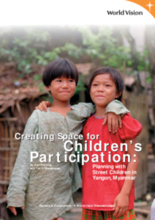World Vision’s Street and Working Children (SWC) Program in Yangon and Mandalay commenced in April 1997. The Lan Paw Kale (LPK) is an integral part of this umbrella program and focuses on street children in Yangon. The SWC Program has two main components. The first is “curative” and aims to improve the quality of life and status of street and working children in these two cities and when possible, to reintegrate them into mainstream society. The second is “preventive” which seeks to address the underlying factors pushing kids onto the street in a number of poorer communities around Yangon. It offers assistance to children at risk of becoming street children to seek strategies to resolve their problems whilst staying with their families and their communities. The “curative” component commenced first. A short time later the program expanded to include the “preventative” component.
The evaluation described in this report focuses on the first component. With assistance from World Vision Australia (WVA), World Vision Myanmar (WVM) conducted a two-week ‘empowerment’ evaluation of the Street Children & Working Children (SWC) Program. Consistent with the main aim of Empowerment Evaluation, the key objective of this evaluation was to provide capacity for the project participants (especially the ‘users’ or ‘beneficiaries’ - the children) to evaluate and be involved with project decision making. The intention was that this participation would continue beyond the scope of this evaluation and throughout the project.
This report gives a detailed outline of the project background, the methodology employed to guide the evaluation questions, and the structure and implementation of the of the evaluation process. The report concludes with evaluation team recommendations and lessons learned in working with children. The methods for encouraging and eliciting child participation in this evaluative study could inform future efforts to consult with children in comparable settings.
©World Vision Australia

